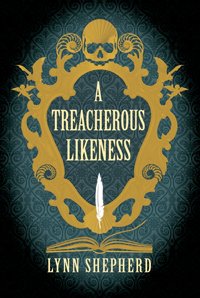 Written by Lynn Shepherd — There is a small but growing body of crime fiction featuring real historical people – Jed Rubenfeld’s Sigmund Freud series, for instance, or Nicola Upson’s Josephine Tey. In this book it’s the Romantic Poets, particularly Percy Bysshe Shelley, who take centre stage. There is always a danger that the reinterpretation of historical facts may offend ardent admirers of those historical figures, so if you’re a Shelley fan you may want to look away now! But if you do, you’ll be missing out on a rather intriguing, atmospheric read.
Written by Lynn Shepherd — There is a small but growing body of crime fiction featuring real historical people – Jed Rubenfeld’s Sigmund Freud series, for instance, or Nicola Upson’s Josephine Tey. In this book it’s the Romantic Poets, particularly Percy Bysshe Shelley, who take centre stage. There is always a danger that the reinterpretation of historical facts may offend ardent admirers of those historical figures, so if you’re a Shelley fan you may want to look away now! But if you do, you’ll be missing out on a rather intriguing, atmospheric read.
A Treacherous Likeness (or A Fatal Likeness in the US) is the second in a mystery series set in mid-Victorian London and follows on from Tom-All-Alone’s, which was inspired by Bleak House. It sees the return the thief-taker Charles Maddox, a 19th century detective. Maddox is losing his appetite for the job. His great-uncle, who taught him everything about the art and science of investigation, has suffered something resembling a stroke and nothing seems to break through his comatose state.
Young Charles is hired by the only surviving son of Percy Bysshe Shelley to find someone who is trying to sell some of the poet’s personal papers. At first, he believes the case to be a straightforward, if somewhat petty, wrangling over literary legacy. However, he soon discovers that the owner of these papers is none other than Claire Clairmont, stepsister of Mary Shelley, notorious for her affair with Lord Byron and for accompanying Shelley and Mary when they eloped abroad.
Falling under the spell of this seductive woman twice his age, he decides to re-examine the death by suicide of Shelley’s first wife, Harriet. As he delves deeper into the personal tragedies and many mysterious gaps in the lives of Shelley and his circle, he begins to suspect that there were some hidden reasons why he was chosen to conduct the investigation. To his horror, he realises that his revered great-uncle may have been involved in covering up some terrible crimes. Why did Shelley never regain custody of his children from his first marriage? What was the real relationship between Claire and Shelley? Was Mary a devoted wife who put her own literary ambitions second, or a manipulative temptress?
The author uses extensive historical research most effectively, to create a persuasive reinterpretation of well-documented facts. However, too frequently she intervenes from the position of an omniscient 21st century narrator. These passages are probably intended as a foil for what might otherwise descend into a pastiche of Wilkie Collins or Dickens, but I found the juxtaposition grating.
Shepherd’s conclusions are disturbing – I, for one, will certainly never view Shelley in quite the same light again. However, there are no startling new revelations here which others have not speculated about previously. The colourful lifestyle, radical political views and ideal of free love, as well as the early deaths of both Shelley and Byron, have inspired countless films and novels. This book is better informed than most, and has the pace, suspense and intermittent darkness of a Gothic novel. Fans of historical crime fiction will appreciate the lovingly observed period detail and careful rendition of Victorian prose style, with a nicely woven in mystery angle.
UK readers can get a copy for just 99p at the moment, for Kindle.
Corsair
Print/Kindle/iBook
£0.99
CFL Rating: 4 Stars








